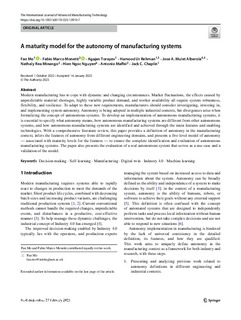| dc.rights.license | Attribution 4.0 International | * |
| dc.contributor.author | Nguyen Ngoc, Hien | |
| dc.contributor.other | Mo, Fan | |
| dc.contributor.other | Marco Monetti, Fabio | |
| dc.contributor.other | Torayev, Agajan | |
| dc.contributor.other | Rehman, Hamood Ur | |
| dc.contributor.other | Mulet Alberola, Jose A. | |
| dc.contributor.other | Minango, Nathaly Rea | |
| dc.contributor.other | Maffei, Antonio | |
| dc.contributor.other | Chaplin, Jack C. | |
| dc.date.accessioned | 2023-03-20T07:29:59Z | |
| dc.date.available | 2023-03-20T07:29:59Z | |
| dc.date.issued | 2023 | |
| dc.identifier.issn | 1433-3015 | en |
| dc.identifier.other | https://katalogoa.mondragon.edu/janium-bin/janium_login_opac.pl?find&ficha_no=171908 | en |
| dc.identifier.uri | https://hdl.handle.net/20.500.11984/6042 | |
| dc.description.abstract | Modern manufacturing has to cope with dynamic and changing circumstances. Market fluctuations, the effects caused by unpredictable material shortages, highly variable product demand, and worker availability all require system robustness, flexibility, and resilience. To adapt to these new requirements, manufacturers should consider investigating, investing in, and implementing system autonomy. Autonomy is being adopted in multiple industrial contexts, but divergences arise when formalizing the concept of autonomous systems. To develop an implementation of autonomous manufacturing systems, it is essential to specify what autonomy means, how autonomous manufacturing systems are different from other autonomous systems, and how autonomous manufacturing systems are identified and achieved through the main features and enabling technologies. With a comprehensive literature review, this paper provides a definition of autonomy in the manufacturing context, infers the features of autonomy from different engineering domains, and presents a five-level model of autonomy — associated with maturity levels for the features — to ensure the complete identification and evaluation of autonomous manufacturing systems. The paper also presents the evaluation of a real autonomous system that serves as a use-case and a validation of the model. | en |
| dc.description.sponsorship | Comisión Europea | es |
| dc.language.iso | eng | en |
| dc.publisher | Springer | en |
| dc.rights | © 2023 The Authors | en |
| dc.rights.uri | http://creativecommons.org/licenses/by/4.0/ | * |
| dc.subject | Decision-making | en |
| dc.subject | Self-learning | en |
| dc.subject | manufacturing | en |
| dc.subject | digital twin | en |
| dc.subject | industry 4.0 | en |
| dc.subject | Machine learning | en |
| dc.subject | ODS 9 Industria, innovación e infraestructura | es |
| dc.title | A maturity model for the autonomy of manufacturing systems | en |
| dcterms.accessRights | http://purl.org/coar/access_right/c_abf2 | en |
| dcterms.source | International Journal of Advanced Manufacturing Technology | en |
| local.contributor.group | Ingeniería del software y sistemas | es |
| local.description.peerreviewed | true | en |
| local.identifier.doi | https://doi.org/10.1007/s00170-023-10910-7 | en |
| local.relation.projectID | info:eu-repo/grantAgreement/EC/H2020/814078/EU/Digital Manufacturing and Design Training Network/DiManD | en |
| local.contributor.otherinstitution | https://ror.org/01ee9ar58 | en |
| local.contributor.otherinstitution | https://ror.org/026vcq606 | en |
| local.contributor.otherinstitution | TQC Automation Ltd. | en |
| local.contributor.otherinstitution | National Research Council | en |
| local.contributor.otherinstitution | https://ror.org/02q2d2610 | en |
| oaire.format.mimetype | application/pdf | en |
| oaire.file | $DSPACE\assetstore | en |
| oaire.resourceType | http://purl.org/coar/resource_type/c_6501 | en |
| oaire.version | http://purl.org/coar/version/c_970fb48d4fbd8a85 | en |








